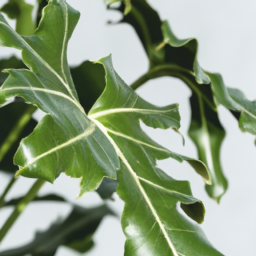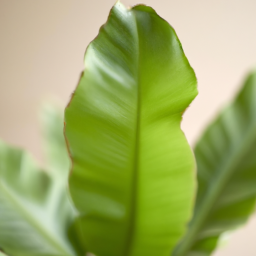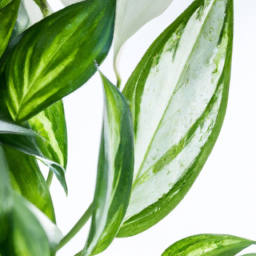
Are you looking to add some greenery to your home or office space? Foliage plants are the perfect solution! These plants are known for their lush and vibrant leaves, making them a great addition to any room. Whether you have a green thumb or are just starting out with plants, foliage plants are easy to care for and can brighten up any space. In this blog post, we will explore the world of foliage plants, including different types, care tips, and how to incorporate them into your decor. So, let’s dive in and discover the beauty of foliage plants!
Benefits of Having Foliage Plants in Your Home
Welcome to our guide on the benefits of having foliage plants in your home! Foliage plants are a great addition to any indoor space, not only for their aesthetic appeal but also for the numerous health and wellness benefits they provide. In this article, we will explore the various advantages of incorporating foliage plants into your home decor.
Improved Air Quality
One of the most well-known benefits of having foliage plants in your home is their ability to improve indoor air quality. Plants absorb carbon dioxide and release oxygen through the process of photosynthesis, which helps to purify the air and create a healthier living environment. In addition, many foliage plants have been shown to remove toxins such as formaldehyde, benzene, and trichloroethylene from the air, making them natural air purifiers.
Some of the best foliage plants for improving air quality include peace lilies, spider plants, snake plants, and pothos. These plants are low-maintenance and can thrive in a variety of indoor conditions, making them ideal for beginner gardeners or those with busy lifestyles. By incorporating these plants into your home, you can breathe easier and enjoy cleaner, fresher air.
In addition to their air-purifying properties, foliage plants also help to increase humidity levels in indoor spaces, which can be beneficial for respiratory health. By releasing moisture through their leaves, plants can help to alleviate dry air and reduce symptoms such as dry skin, sore throats, and respiratory issues.
Stress Reduction
Another major benefit of having foliage plants in your home is their ability to reduce stress and improve overall well-being. Studies have shown that spending time in nature or surrounded by greenery can have a calming effect on the mind and body, helping to reduce feelings of anxiety and stress.
By bringing the outdoors inside with foliage plants, you can create a peaceful and relaxing environment that promotes mental clarity and emotional well-being. Simply caring for plants, such as watering and pruning, can also be a meditative and therapeutic activity that helps to alleviate stress and promote mindfulness.
In addition, the presence of foliage plants in indoor spaces has been linked to increased productivity, creativity, and overall happiness. By creating a green and vibrant environment, you can boost your mood and energy levels, leading to a more positive and productive lifestyle.
Enhanced Aesthetic Appeal
Aside from their health benefits, foliage plants also add a touch of beauty and elegance to any home decor. With their lush green leaves, unique textures, and vibrant colors, foliage plants can serve as natural works of art that enhance the visual appeal of any room.
Whether you choose to display a single statement plant or create a lush indoor jungle, foliage plants can transform your living space into a tranquil oasis that reflects your personal style and taste. From sleek and modern to bohemian and eclectic, there are endless possibilities for incorporating foliage plants into your home decor.
Furthermore, foliage plants can be used to create focal points, add depth and dimension to a room, and soften harsh lines or corners. By strategically placing plants in key areas, such as on shelves, tables, or hanging baskets, you can create a cohesive and inviting atmosphere that brings the beauty of the outdoors inside.

Top 10 Low-Maintenance Foliage Plants for Indoor Spaces
Choosing the Right Foliage Plants for Your Indoor Space
When it comes to choosing the right foliage plants for your indoor space, there are a few key factors to consider. First and foremost, you’ll want to think about the amount of natural light that your space receives. Some foliage plants thrive in bright, indirect light, while others are better suited to low-light conditions. Additionally, consider the size of your space and the overall aesthetic you’re going for. Are you looking for a statement plant to serve as a focal point, or do you want to create a lush, green oasis? Once you’ve thought about these factors, you can start exploring your options.
One popular choice for low-maintenance foliage plants is the snake plant, also known as Sansevieria. This plant is incredibly resilient and can thrive in a variety of light conditions, making it perfect for beginners or those with less-than-ideal lighting situations. Another great option is the pothos plant, which features cascading vines and heart-shaped leaves. Pothos plants are known for their air-purifying qualities and can thrive in low-light environments. If you’re looking for a plant that adds a pop of color to your space, consider the Chinese evergreen. This plant comes in a variety of shades, from deep green to silver and pink, and is incredibly easy to care for.
Caring for Your Foliage Plants
Once you’ve selected the perfect foliage plants for your indoor space, it’s important to know how to care for them properly. While low-maintenance plants are generally easy to care for, they still require some attention to thrive. One of the most important things to consider is watering. Overwatering is a common mistake that can lead to root rot and other issues, so be sure to let the soil dry out between waterings. Additionally, make sure to dust your plant’s leaves regularly to keep them healthy and free from pests.
In terms of light, most low-maintenance foliage plants prefer bright, indirect light, but can also tolerate low-light conditions. If you notice your plant’s leaves turning yellow or brown, it may be getting too much or too little light. Finally, consider fertilizing your plants every few months to ensure they have the nutrients they need to thrive. Choose a balanced, water-soluble fertilizer and follow the instructions on the packaging for best results.
Benefits of Having Foliage Plants in Your Indoor Space
There are numerous benefits to having foliage plants in your indoor space, beyond just adding a touch of greenery to your decor. One of the most well-known benefits is their air-purifying qualities. Plants absorb carbon dioxide and release oxygen through photosynthesis, helping to improve air quality and create a healthier living environment. In addition, studies have shown that having plants in your space can reduce stress, boost mood, and increase productivity.
Foliage plants can also help to create a sense of calm and tranquility in your space, making them perfect for bedrooms, home offices, and other areas where you want to relax and unwind. Finally, caring for plants can be a rewarding and therapeutic experience, allowing you to connect with nature and take a break from the stresses of daily life. So whether you’re a seasoned plant parent or just starting out, adding foliage plants to your indoor space is a great way to enhance your environment and improve your overall well-being.

How to Properly Care for Your Foliage Plants: A Beginner’s Guide
The Importance of Proper Care for Foliage Plants
Foliage plants are a popular choice for indoor and outdoor gardening due to their vibrant colors and unique textures. Proper care is essential to ensure that your foliage plants thrive and remain healthy. By following a few simple guidelines, you can enjoy beautiful foliage plants that will brighten up your home or garden.
First and foremost, it is important to understand the specific needs of your foliage plants. Different types of foliage plants require different levels of light, water, and humidity. Some plants may thrive in bright, indirect sunlight, while others prefer low light conditions. Research the specific requirements of each plant in your collection to ensure that you are providing the optimal growing conditions.
In addition to light, water is a crucial element in caring for foliage plants. Overwatering is a common mistake that can lead to root rot and other issues. On the other hand, underwatering can cause the leaves to wilt and the plant to become stressed. It is important to water your foliage plants consistently, allowing the soil to dry out slightly between waterings. Be sure to use a well-draining potting mix to prevent water from pooling at the bottom of the pot.
Humidity levels can also impact the health of your foliage plants. Some plants, such as ferns and tropical varieties, thrive in high humidity environments. To increase humidity levels, you can mist your plants regularly or place a humidifier nearby. Alternatively, you can group your plants together to create a microclimate with higher humidity levels.
Proper Lighting for Foliage Plants
Light is essential for photosynthesis, the process by which plants convert light into energy. Foliage plants require varying levels of light depending on their species. Plants that are native to tropical regions typically require bright, indirect sunlight, while plants that are native to shaded forests thrive in low light conditions.
To determine the optimal lighting conditions for your foliage plants, observe how they respond to the light in your home or garden. If a plant’s leaves are turning yellow or becoming scorched, it may be receiving too much light. On the other hand, if a plant’s growth is slow and leaves are pale, it may not be receiving enough light.
If your foliage plants are not receiving adequate light, you can supplement with artificial lighting. LED grow lights are a popular choice for indoor gardening, as they provide a full spectrum of light that mimics natural sunlight. Position the grow lights above your plants at a distance of 12-18 inches to ensure that they receive the proper amount of light.
In addition to light intensity, the duration of light exposure is also important for foliage plants. Most plants require 12-16 hours of light per day to thrive. To achieve this, you can use a timer to regulate the amount of light your plants receive. Be sure to allow your plants to rest at night, as they require a period of darkness for optimal growth.
Pruning and Maintenance Tips for Foliage Plants
Regular pruning is essential for maintaining the health and appearance of your foliage plants. Pruning helps to remove dead or diseased foliage, promote new growth, and maintain the shape of the plant. To prune your foliage plants, use clean, sharp scissors or pruning shears to make clean cuts at a 45-degree angle.
When pruning your plants, be sure to remove any yellowing or brown leaves, as these can indicate a nutrient deficiency or overwatering. Trim back any leggy growth to encourage the plant to produce new, bushy growth. You can also pinch off the tips of the stems to promote branching and create a fuller plant.
In addition to pruning, regular maintenance tasks such as repotting and fertilizing are important for the overall health of your foliage plants. Repot your plants every 1-2 years to provide fresh soil and room for growth. Choose a pot that is slightly larger than the current one, with good drainage holes to prevent waterlogging.
Fertilizing your foliage plants is also essential to provide them with the nutrients they need to thrive. Use a balanced, water-soluble fertilizer every 4-6 weeks during the growing season. Be sure to follow the manufacturer’s instructions for dilution and application, as overfertilizing can lead to nutrient imbalances and plant stress.
By following these simple care guidelines, you can enjoy healthy, vibrant foliage plants that will enhance the beauty of your home or garden. With proper lighting, watering, and maintenance, your foliage plants will thrive and bring joy for years to come.
Summary Snapshot
If you’re looking to add some greenery to your indoor space, foliage plants are a great option to consider. These plants are known for their lush and vibrant leaves, making them a beautiful addition to any room. Not only do they add a pop of color and life to your space, but they also have the added benefit of improving air quality by releasing oxygen and removing toxins from the air.
Foliage plants come in a variety of shapes, sizes, and colors, making it easy to find the perfect plant to suit your style and space. From large, statement-making plants like fiddle leaf figs to smaller, more delicate options like pothos or spider plants, there is a foliage plant for every preference. Whether you’re a seasoned plant parent or just starting out, adding a foliage plant to your indoor garden is a great way to bring the beauty of the outdoors inside and create a more welcoming and relaxing atmosphere in your home.
FAQ Compilation:
Q1: What are foliage plants?
A1: Foliage plants are plants that are grown for their attractive leaves rather than their flowers. They come in a variety of shapes, sizes, and colors, making them popular choices for indoor and outdoor gardens.
Q2: What are some popular types of foliage plants?
A2: Some popular types of foliage plants include pothos, snake plants, peace lilies, and spider plants. These plants are known for their low maintenance and ability to thrive in a variety of environments.
Q3: How do I care for foliage plants?
A3: Foliage plants generally require regular watering, proper lighting, and occasional fertilization. It’s important to research the specific care requirements for each type of foliage plant to ensure it thrives in your home or garden.
Q4: Can foliage plants improve indoor air quality?
A4: Yes, foliage plants are known for their air-purifying qualities. They can help remove toxins from the air and increase oxygen levels, making them a great addition to any indoor space.
Q5: Where can I buy foliage plants?
A5: Foliage plants can be purchased at garden centers, nurseries, and online plant shops. It’s important to choose a reputable seller and select plants that are healthy and well-suited to your specific environment.
Dr. Olivia Green is a botanist with over two decades of experience in indoor plant cultivation. She holds a Ph.D. in Plant Biology and has dedicated her career to researching plant behavior in controlled environments. Dr. Green is passionate about helping plant enthusiasts master the art of indoor gardening through her extensive knowledge and practical insights.


